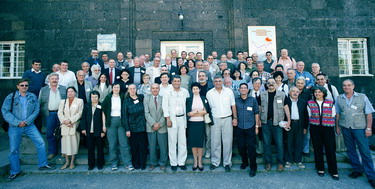Space Weather Symposium in Armenia Attracts
75 Participants from 11 Countries
By Anahid Yeremian
November 5, 2005

Solar Extreme Events – 05 conference participants in front of the Nor Ambert research and conference center of the Cosmic Ray Division.
(Photo courtesy of Vahe Peroomian)
Over 75 scientists from 11 countries, participated in the Space Weather symposium organized by the Cosmic Ray Division (CRD) of the Alikhanyan Physics Institute from September 26-30, 2005. The symposium was funded by the International Science and Technology Center (ISTC), the international Commission On Space Research (COSPAR) and participant registration fees. It was listed on the NASA and COSPAR website calendars, drawing new faces from scientific organizations and industry who are showing interest in Space Weather issues. As a reminder for our readers, Space Weather is defined as processes that occur in space due to the activity of the sun. Just as on earth we have wind, rain, and storms; in space we have solar winds, particle showers, and geomagnetic storms, all due to powerful irruptions on the sun. Some of these are so severe that they damage satellites in orbit and power stations on the ground. Indirectly they affect every fabric of society, be it reliable use of cell phones, monitoring of earthly weather, businesses and systems that depend on electricity. Space weather can harm personnel on space missions and over the polar flights. As is the case for predicting weather on earth, if we can predict the arrival of the severe space weather conditions and take mitigating action to protect against them, we can save billions of dollars of damage to our infrastructure, reduce radiation related illnesses in people and even saves lives.
Steered by an international advisory group co-chaired by Prof. Ashot Chilingarian, head of the CRD and Prof. Michael Panasyuk, head of Space Weather Research at Moscow State University, the conference program focused on the sources of Space Weather and the detection and early warning of events with catastrophic consequences.
Head scientists of the Spaceship Earth program and top scientists from the astronomy or space weather research departments of Stanford, UCLA, Delaware, Bern, Nagoya, Moscow, and Yerevan State Universities were among the participants. They and representatives from NASA, the European Space Agency (ESA), the European Commission On Science and Technology’s (COST) space weather program, as well as the CRD Students from Yerevan State University and a graduate student from University of Costa Rica made presentations and insightful observations on data gathering, analysis and alert systems for space weather. Collaborative efforts to correlate data from around the world for a more reliable alert service were among the major topics. To this end, the CRD scientists in Armenia presented two different prototype space weather monitors that they designed. These monitors are reasonably portable and modular and can be made in quantity to place around the world, much like a weather research group might place barometers, thermometers and wind speed measuring devices around the world to monitor pending severe weather conditions, but in this case space weather conditions.
For many of the participants, particularly those who registered based on the announcement on the NASA and COSPAR calendars, this was their first trip to Armenia. Thus the local organizing committee headed by Prof. Chilingarian, organized sightseeing excursions on two of the evenings, and an ice-breaker dinner on the first night of the conference. Participants had the “time of their lives” (W. Saroyan) dancing Armenian shurch-bars and getting acquainted with Armenian hospitality.
A tour of the two Cosmic Ray research stations on Mt. Aragats rounded off the outstanding week on the last day of the conference. Comments about the unique and important capabilities of the Cosmic Ray Division, both in infrastructure and human expertise, was a comment that was heard many times from the visitors, as they toured the facilities.
During the closing session discussions moderated by Prof. Chilingarian, he asked the participants if this conference should become a series and how often it should occur. The consensus was that the conference needed to become an annual series because of the huge implications of space weather on critical and expensive systems which we rely on for our daily lives, the rapid growth in our understanding of the mechanisms that drive space weather conditions, and evolving scenarios for reliable early warning alerts. The final question from Prof. Chilingarian was, “And so which country should host the conference nest year?” the answer from the audience was unanimous and in unison “There is no better place than Armenia”. To which Prof. Chilingarian replied, “We have many interesting and beautiful places in Armenia that you have not seen yet. We will be glad to host the conference next year.”
Next year we look forward to the returning scientists, this time with their spouses and friends, as we were requested to include a spouses program next year. That’s a program during the day, when the scientists sit in meeting rooms discussing their work, while their accompanying spouses and friends go sightseeing! We in the Support Committee for Armenia’s Cosmic Ray Division (SCACRD) are proud of the accomplishments of the CRD. CRD’s supporters should, justifiably, be extremely proud that their support of the CRD is putting Armenia on the map as a powerful contributor to solving one of the world’s most important challenges, the understanding and alerting on space weather, while also giving a boost to Armenia’s tourist industry and creating good will towards Armenia around the world. CRD personnel expressed to SCACRD members at the conference that they are extremely appreciative for the confidence and support that they have received from the Diaspora. For more information about the Cosmic Ray Division or how you can get involved with such a dynamic and winning program, please visit www.crdfriends.org or call Anahid Yeremian at 650 – 926 – 4444.